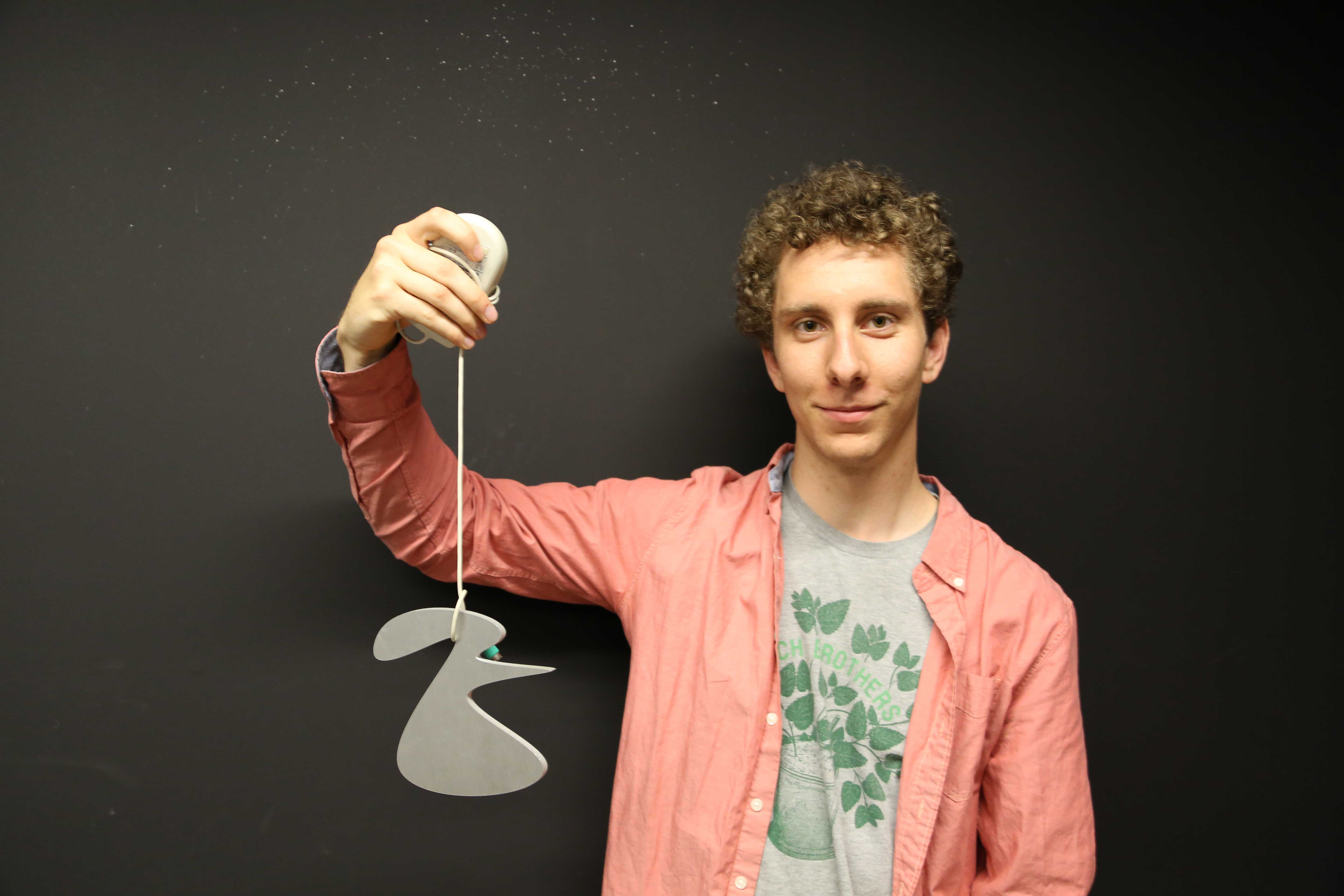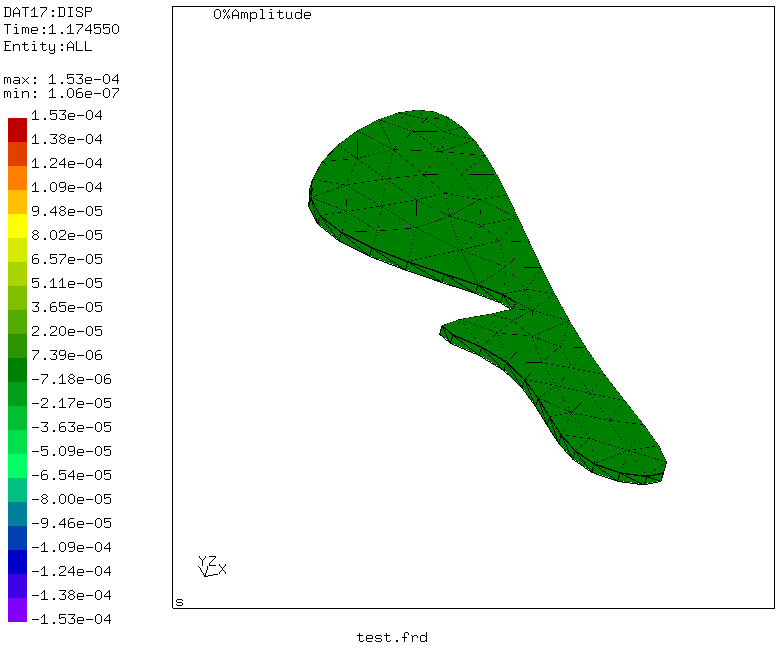
IRIS login | Reed College home Volume 96, No. 2: June 2017
Physics Major Invents New Musical Instrument

Evan Peairs ’16 invented a musical instrument for his physics thesis by borrowing ideas from aerospace and structural engineering. Photo by Chris Lydgate
Physics major Evan Peairs ’16 has built a new kind of bell for his senior thesis using an innovative design that is capable, in theory, of generating musical tones never previously achieved by a percussive instrument.
The instrument—which is related to a musical family known as the bell plate—consists of a slab of aluminum carved in an otherworldly shape that resembles a mutant unicorn. When you strike it with your finger, however, it rings with the sweet, reverent chime of a church bell.

The instrument sounds exactly like a church bell, but the design can be modified to sound like a gong, a xylophone, and even a trumpet. Photo by Chris Lydgate
Using the acoustical wizardry he developed for his thesis, Evan is now designing bell plates that sound like a gong, a xylophone, and a woodblock. “And I’m working on one that sounds like a trumpet,” he adds, showing a visitor around a laboratory in the Physics Building that bristles with lasers, mirrors, wires, pipes, and imposing electronic gadgetry.
Evan has a longstanding interest in obscure musical instruments, and originally thought of writing his thesis on the acoustics of church bells. But it turns out that church bells are expensive and difficult to make. So he began to investigate other instruments, including bell plates—rectangular sheets of metal which sound vaguely like gongs.
One day he asked himself what would happen if he changed the shape of the plate. “I thought it was kind of strange that bell plates were always rectangular,” he says. “Nobody ever thought to change the contour.”
It turns out that changing the contour has a striking effect on the tone. Using an engineering technique known as structural optimization, Evan set about designing a bell plate that sounded just like church bell. To accomplish this, he made a recording of a church bell and analyzed its sound, which is made up of a distinctive signature of overtones. With the help of some heavy math, he translated that overtone signature into a complex two-dimensional shape known as a spline curve, traced the spline curve onto a sheet of aluminum using a waterjet cutter, and punched out a bell plate with identical resonant properties to the church bell: when struck, it produces the same mellow tone.
“This project was completely Evan’s own idea and I feel like I’ve been on a super fun, wild ride with him all year,” says his thesis advisor, Prof. John Essick [physics 1993–]. “A few months ago, Evan brought back the flat plate from the machine shop that he had cut into a shape that looked like a fanciful misshaped unicorn and said that his computer simulation had predicted that it would vibrate just like a church bell. When he flicked it with his finger and it sounded exactly like a church bell, I was stunned. I thought, ‘Wow, this crazy, whimsical idea actually works.’”
To verify that the resonance was not a freak accident, Evan used electronic speckle pattern interferometry, which involves bouncing a laser off an instrument and beaming the reflection into a camera. When the instrument is struck, its vibrations cause interference in the laser beam which creates a unique pattern. If the pattern of the bell plate matches the pattern of the church bell, the instruments have the same resonant properties—even though they look totally different.
Evan wasn’t satisfied, however. “The church bell was a good target to start with,” he says. “But once I figured it out, I asked myself, ‘Why stop there?’”
By altering the contour—one looks like a coiled python, another bears vague resemblance to the state of California—he can make instruments with all kinds of voices, from the hollow thunk of a xylophone to the sunburst cadence of a pipe organ. He can even design instruments with bizarre sounds, hitherto unknown.

This bell plate sounds like an organ.
The musical aspect of his thesis suits Evan, who plays mandolin, guitar, and bodhrán, and who took several classes in the music department during his time at Reed. He also operated Reed’s nuclear reactor and led the madcap student construction group Defenders of the Universe, which builds outlandish contraptions such as a giant hamster wheel, a walking machine, and a seesaw bicycle.
His thesis is titled “Designing, Building, and Testing Novel Musical Instruments.” He also gave a shout-out to Prof. Jerry Shurman [math] and Prof. Morgan Luker [music].
After Reed, he plans to go to the Bay Area and look for a job in robotics. “I want to build things to help the world,” he says.


LATEST COMMENTS
steve-jobs-1976 I knew Steve Jobs when he was on the second floor of Quincy. (Fall...
Utnapishtim - 2 weeks ago
Prof. Mason Drukman [political science 1964–70] This is gold, pure gold. God bless, Prof. Drukman.
puredog - 1 month ago
virginia-davis-1965 Such a good friend & compatriot in the day of Satyricon...
czarchasm - 4 months ago
John Peara Baba 1990 John died of a broken heart from losing his mom and then his...
kodachrome - 7 months ago
Carol Sawyer 1962 Who wrote this obit? I'm writing something about Carol Sawyer...
MsLaurie Pepper - 8 months ago
William W. Wissman MAT 1969 ...and THREE sisters. Sabra, the oldest, Mary, the middle, and...
riclf - 10 months ago